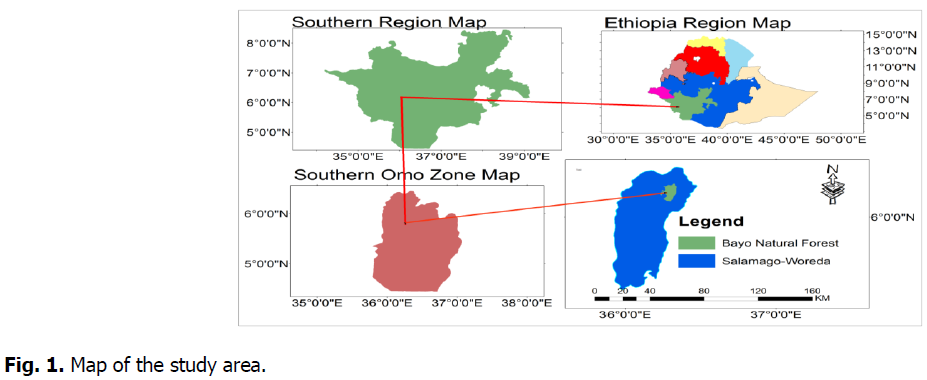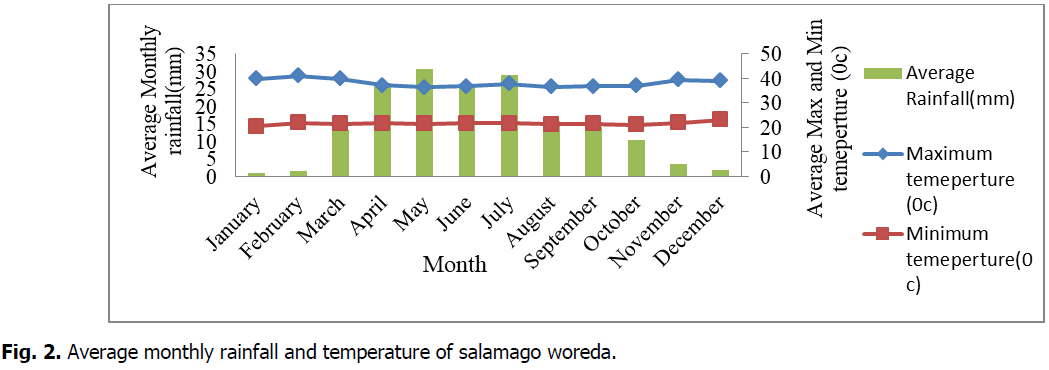Research - (2023) Volume 13, Issue 3
Diversity of diurnal large mammals in bayo community managed forest, salamago woreda, south omo zone, Southern Ethiopia
T.H. Chankallo1* and S.T. Kabtehyimer2Abstract
An ecological study on diurnal mammals was carried out in Bayo Community Managed Forest located in Salamago Woreda, South Omo Zone. The objective of the study was to investigate the diversity of diurnal large mammals in the study area. Based on the habitat type and topography of the study area, 11 transect, i.e., 7 in forestland and 4 in Wooded Grassland were laid to collect the data. Besides direct methods, indirect methods such as faecal droppings, fresh tracks, carcass or shell count, den (burrow), hair, and digging were used. Data were analyzed using descriptive statistics, SPSS and SMART software. A total of 20 species of diurnal large mammals belonging to six orders and eight families were identified. The species identified were Cercopithecus pygerythrus, Cercopithecus aethiops, Papio anubis, Erytherocebus patas, Cercopitheus neglectus, Colobus guereza, Equus quagga, Traglaphus strepsiceros, Traglaphus imberbis, Traglaphus scriptus, Medagua guentheri, Sylvicapra grimma, Kobus ellipsiprymnus defessa, Syncerrus caffer, Potamochoerus larvatus, Phacochoerus africanus, Hylochoerus meinertzhageni, Hystrix cristata, Orycteropus afer, and Phataginus temminckii smutus. Seasonal variation in the number of species was not significant (X2=0.024, df=1, p>0.05). Seasonal abundance was significant (X2=5.614, df=1, p<0.05). Totally, 685 and 600 mammals were counted during wet and dry seasons, respectively. On habitat basis, 683 and 602 animals were recorded in forestland and wooded grassland habitats, respectively. The male to female aggregate sex ratio was 0.98:1.00 which was female-biased. However, species wise, female-biased, male-biased and 1:1 male to female sex ratio was recorded. Age structure comprised of the predominantly adult population and aggregate age ratio of adult to young was 1:0.74 and 1:0.57 during the wet and dry seasons, respectively. The highest species diversity (H=2.53) was recorded in the wooded grassland habitat The local government should promote the study area and provide appropriate support for its conservation.
Keywords
Bayo community managed forest, Diurnal mammals, Diversity, Relative abundance and species compostion.
Introduction
Mammals are the highest evolved group of the animal kingdom (Ghose, K.C., Manna, B., 2003). Class Mammalia is composed of 1,229 genera and 5487 species of living mammals which is placed in 29 orders, and 125 families with an additional 5 to 12 new species named each year (Wilson, D.E., Reeder, D.M., 2016). More than 1,150 species of mammals are found in Africa and 360 species were found in eastern Africa (Gebo, B., Takele, S., Shibru, S., 2021). Tropical Africa has greater mammalian diversity than any other area of the world (Kingdom, J., 2015). This region supports most of the mammalian fauna (Rainer, W. Bussmann 2006; Oluseun, A.A., 2017). Fifteen per cent of large-sized mammalian species distribution and abundance are found in most forest and savannah regions in Africa and it is of the utmost importance to protect them for the role they play in the ecosystem (Agebo, A., Tekalign, W., 2021).
Ethiopia is located in the Horn of Africa between 3°N and 15°00’N longitude and 33°00’E and 48°00’E latitudes and covers an area of 1.13 million km² (of which 1.12 and 0.01 million km² are land and water bodies, respectively) (EWNHS, 1996; Asefa, M., et al., 2020). There are five biomes and various sets of ecosystems (Friis, I., et al., 2010; Getahun, A.A., 2018). The altitudinal difference ranges from the highest peak at Ras Dashen (4620 m) to (126 m) below sea level in the Afar depression. Such altitudinal and geographical variations made the country to be among the biodiversity-rich nations in the world (EBI, 2014). The country has established several protected areas since the 1960â??s. There are 179 protected areas under different categories in the country. Accordingly, there are 27 National parks, 2 Wildlife Sanctuaries, 4 Wildlife Reserves, more than 10 Community Conservation Areas, 6 Open Hunting Area, 25 Controlled Hunting areas, 4 Biosphere Reserves areas, 6 wildlife rescue centres, and 95 National Reserve forest areas (EWCA, 2020).
Mammals are mainly concentrated in the southern parts and southwest border and adjacent areas of the country (Lavrenchenko., L., Bekele, A., 2017). The mountain massifs in the north and centre parts are also home to many endemic species of mammals, particularly the Ethiopia wolf (Canis simensis), Gelada baboon (Theropithecus gelada), Menelik’s bushbuck (Tragelaphus scripus Meneliki), Mountain Nyala (Tragelaphus buxtoni), Starch’s hare (Lepus Starcki), Swayne’s, hartebeest (Alcelaphus buselaphus) Starch’s hare (Lepus Starcki)and Waliai Ibex (Capra walie) (Evan, W., et al., 2020). The Ethiopian wild fauna are comprised of 326 mammals, 918 birds, 240 reptiles, 200 fish, 71 amphibians and 1,225 arthropods (324 butterflies). Of these; 177 (57 small to large mammals, 19 birds, 25 reptiles, 30 amphibians, 41 fresh-water fishes, and 7 arthropod species) are endemic species, which results in the countries’ status as a global biodiversity hotspot.
The oldest protected areas in the country are Menagesha suba community-managed forest, Awash National Park, Simen Mountain National Park, Abijatta-Shalla Lakes National Park, and Gambela National Park. The southern part of Ethiopia has diverse biological resources including endemic mammalian species. The protected areas in Southern Nations, Nationalities and People’s Regional State (SNNPR) are Nech Sar National Park, Omo National Park, Mago National Park, Maze National Park, Chebera Chuchura National Park, Loka Abya National Park, Gibe Sheleko National Park, Tama community managed wildlife reserve area and Garameba community-managed forest.
There are few documented studies on mammals of protected areas in the northern, southwestern, southeastern, southern and central parts of Ethiopia Some ecological studies also indicated that mammals are found in natural forests of Ethiopia. However, studies on the population ecology of diurnal mammals are still poorly known in many parts of Ethiopia. The present study area, Bayo community-managed forest, is one of the natural forests located in the Salamago Woreda, South Omo Zone, which is managed by the local communities. It is an area that is endowed with biodiversity, albeit there are no ecological studies on mammals carried out so far. Thus, the present study was aimed to investigate diversity of the diurnal large mammals in the study area. The objectives of the study are therefore as follows; identify species composition, estimate the relative abundance and diversity, and determine sex ratio and age structure of diurnal large mammals in the study area.
Study area
Salamago Woreda is found in South Omo Zone, southern Ethiopia. It is located between 5°21'-6°27'N and 36°21'-37°57'E. The elevation is ranging between 383 m and 2543 m asl. It is about 800 and 530 km southwest of Addis Ababa and Hawassa, respectively, and 374 kms far from Arba Minch and 123 km from Jinka (capital city of South Omo) (Fig. 1). The word "Salamago" named after the name of two streams-"Sala" and "Mago". Bayo community-managed natural forest is located in Salamago Woreda. Bayo or ''Kub Gasho'' named closed and no human interface forest in Dime ethnic group language (Biyo is the Amharic name of forest). It is located between 6°14'30''-6°15'0''N and 36°13'30-36°19'30''E. The elevation is ranging between 900 m and 2543 masl. It is about 24 km from Salamago Woreda (Hana city). The forest area coverage is 109.81 km2 (10,981 ha).
Fig 1: Map of the study area.
Climate
The rainfall in the region is bi-modal. Main rainy season is from March to July and short rainy season is from August to September (SNNPRS, 2006). The mean monthly maximum and minimum temperatures are 41.14°C and 20°C, respectively (Fig. 2).
Fig 2: Average monthly rainfall and temperature of salamago woreda.
Materials and Methods
Material used for this study include: Binocular, Telescope, Digital camera, Field data sheet, Global positioning system, satelite map, compass, Kingdon Field guide of mammals, Data Sheet, Notebook, IPhone mobile, CyberTracker, SMART software for special data created for our purpose.
Research approach and research design (sampling technique)
Quantitative research approach was deployed to conduct this research. Based on habitat type and topography, the study area stratified into two-forestland and wooded grassland. Then transect were laid in each habitat type. On these transects direct survey methods were used to collect data on diversity and species composition of diurnal mammals in the study area. Besides, indirect survey methods such as fecal droppings, fresh tracks, Carcass or shell count, Den (burrow), hair, and digging were used.
Sampling techniques for mammal’s survey
Line transect sampling method was used to study diversity and species composition of diurnal large mammals in the forest following. Starting and end points of each transect line was delineated by GPS and permanent natural signs. The total area coverage of the Bayo community managed forest is 109.81 km2, of which 42.34% (46.5 km2) of the study area was sampled. With respective to habitat types 31.86 km2 and 14.64 km2 forestland and wooded grassland, respectively. The number potential transects were 64 in both habitat types considering the steep flates and clip area. Depending on the sampled area, a total of 11 actual transect lines were randomly established, 7 in forestland, and 4 in the wooded grassland. The length of transect line was varied from 3.5 to 5 km depending on the habitat and topography. For selected and surveyed transect lines, the total length was 46.5 km; of which 29.5 km was in forestland and 17 km was in wooded grassland. The gap between consecutive transects was maintained at 0.5 km to avoid any double counting of animals in the study area. To avoid edge effects, steep flates and clip area, transects were spaced 0.2 km from the edge of the each habitat types, steep flates and clip (Table 1 and Fig. 3).
| Number | Length(km) | Habitat | Area (Length and width) |
|---|---|---|---|
| Transect1 | 5 km | Forestland | 5 km*1 km=5 km2 |
| Transect2 | 4.5 km | Forestland | 4.5 km*1 km=4.5km2 |
| Transect3 | 4 km | Forestland | 4 km*1 km=4km2 |
| Transect4 | 4 km | Forestland | 4 km*1 km=4km2 |
| Transect5 | 4 km | Forestland | 4 km*1 km=4km2 |
| Transect6 | 3.5 km | Forestland | 3.5 km*1 km=3.5 km2 |
| Transect7 | 4.5 km | Forestland | 4.5 km*1 km=4.5 km2 |
| Transect8 | 5 km | wooded grassland | 5 km*1 km=5 km2 |
| Transect9 | 5 km | wooded grassland | 5 km*1 km=5 km2 |
| Transect10 | 3.5 km | wooded grassland | 3.5 km*1 km=3.5 km2 |
| Transect11 | 3.5 km | wooded grassland | 3.5 km*1 km=3.5 km2 |
Table 1. Sampled line transects in the study area.
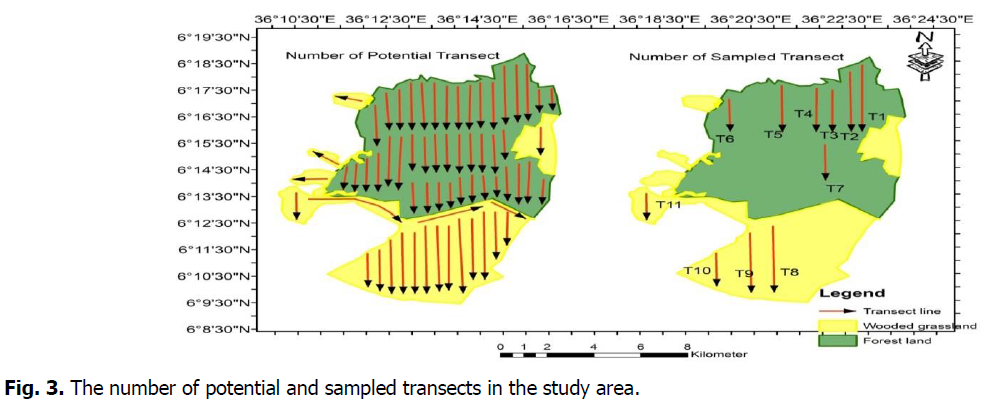
Fig 3: The number of potential and sampled transects in the study area.
Field mammals survey
Data were collected from Feburary to December 2021. Both wet and dry season months were included in the study. Thus, seasonal data were collected during May-July 2021 and October-December 2021 for wet and dry seasons, respectively. Transects were visited twice a month during the study period. Transects were traversed on foot with average speed of 2-2.5 km/hr and the starting and ending points of each transect was marked using Garmin 64 GPS. To enhance sampling effort, in a single visit, each transect was walked twice morning hours 06:00-10:00 AM and afternoon from at 02:00-06:00 PM while many mammals are become active for feeding and maximum animal observation was possible. During direct observation both naked eye, telescope and binocular (10*42 mm Resolution) were used to observe animals following the transect route. During transect visit, the researcher and three trained local field assistants were traversed the track lines. Each two were assigned to the left and right side of the transect line and scanned the route following. The field guide of mammals were used for species identification. All data were recorded by using the survey designs from SMART by the CyberTracker application on a mobile device. Back at the office the data were just transferred to the database. After designing a survey and report layout we can apply this standardized layout for the gathered data from each season. Sex and age category (adult male, adult female, sub adult and young) of individuals was identified using morphological features such as body size, body shape, presence and absence of horn, horn size and coat color. Individuals were recorded as Adult Male, Adult Female, Sub-adult Male, Sub-adult Female, young of both sex/age and unknown sex. All mammals encountered along line transects were recorded on data sheet prepared for this purpose. At each observation event, species name, sex and age catagory number of individuals and sighting distance were recorded on the data sheet. Furthermore, indirect evidences of animals presence such as tracks/imprints, fecal/scat and den/burrow found along the transect line were also recorded. The local community of the study area were consulted for vernacular or local name of animals, call and sign identifications of the mammalian species.
Data analysis
The identified species were taxonomically grouped into their respective order, family, species, common and local name was analyised by Microsoft EXCEL program. The conservation status of each species was also identified based on the data generated from IUCN Redlist Species version 2021-1.http//www.iucnredlist.organizatiion. The identified mammals were grouped as common (if probability of observation was 100% in each session of the field observation), uncommon (if probability of observation was more than 50%), and rare (if probability of observation was less than 50%). For species richness computation, the minimum number of species identified were considered. Species richness was analyised by Microsoft EXCEL programs. Relative abundance index was determined using encounter rates (ERs). Encounter rates was calculated as:
Encounter rate=(total number of signs recorded for species)/(distance walked)
For each habitat by dividing the number of signs by distance (km) walked, including both transect and trail walkway within the habitat. When ER<0=no observation, 0.01<ER<0.5=least observation, ER>0.5=High observation. Species diversity of large diurnal mammals among two habitats was calculated using the Shannon-Wiener index of diversity (H’=–∑piLnpi), Where H’=Shannon-Wiener Index, Pi=Proportion of the ith species in the habitat In =Natural logarithm.
The evenness of mammalian species was calculated as:
J=H'/(H'max)
Where J=Shannon Wiener Evenness Index, H’=Shannon Wiener diversity Index, Hmax=lnS=natural logarithm of the total number of species (S) in each site (Southwood and Henderson, 2000). This measure varies between 1 (complete evenness) and 0 (complete unevenness). Chi-square test was used to compare the seasonal variations in species composition and relative abundance at 0.05 levels of significance. Furthermore, the age and sex structure variations were compared seasonally among forest by using Chi-square test at 0.05 levels of significance. The Encounter rates map was analyzed by SMART 5.0.3 version sosftware (Spatial Monitoring and Reporting Tools) versions.
Results
Species composition
In the present study, a total of 20 mammalian species belonging to six orders and eight families were identified. The order Artiodactyla was represented by the highest number of species (ten species) followed by Primates (six species). The order Perissodactyla, Rodentia, Tubulidentata, and Pholidota were represented by one species each. Among Artiodactyla, family Bovidae was represented by the largest number of species (seven) followed by Cercopithecidae (five), Suidae (three), colobidae (one), Equidae (one), Hystricidae (one), Orycteropodidae (one) and Manidae (one) (Table 2).
| Scientific | Common | Local | IUCN | Cites | BCMF Status | Identification | |||||
|---|---|---|---|---|---|---|---|---|---|---|---|
| Name | Name | name | Category | Methods | |||||||
| Order Primates | |||||||||||
| Family Cercopithecidae | |||||||||||
| Cercopithecus pygerythrus | Vervet Monkey | Angum Kar | Least Concern | Appendix II | Common | Direct | |||||
| Cercopithecus aethiops | Grivet monkey | Ftu Kar | Least Concern | Appendix II | Common | Direct | |||||
| Papio Anubis | Anubis Baboon | Gydu | Least Concern | Appendix II | Common | Direct | |||||
| Erytherocebus patas | Patas monkey | Alqum | Least Concern | Appendix II | Uncommon | Direct | |||||
| Cercopitheus neglectus | DE-Brazza’s monkey | Sudn | Least Concern | Appendix II | Common | Direct | |||||
| Family colobidae | |||||||||||
| Colobus guereza | Colobus monkey | Guru | Near- Threatened | Appendix II | Common | Direct | |||||
| Order Perissodactyla | |||||||||||
| Family Equidae | |||||||||||
| Equus quagga | Burchell’s zebra | Kubo yre | Near- Threatened | Appendix II | Common | Direct | |||||
| Odrder Artiodactyla | |||||||||||
| Family Bovidae | |||||||||||
| Traglaphus strepsiceros | Greater kudu | Wugre | Near- Threatened | Appendix II | Common | Direct | |||||
| Traglaphus imberbis | Lesser kudu | Marchne | Near Threatened | Appendix II | Uncommon | Direct | |||||
| Traglaphus Scriptus | Bushbuck | Unibo | Least Concern | Appendix II | Uncommon | Direct | |||||
| Medagua guentheri | Guenther's Dik- dik | Shuno | Least Concern | Appendix II | Uncommon | Direct | |||||
| Sylvicapra grimma | Bush Duiker | Kolfi | Least Concern | Appendix II | Uncommon | Direct | |||||
| Kobus ellipsiprymnus defessa | Defassa waterbuck | Kuku | Near-Threatened | Appendix II | Uncommon | Direct | |||||
| Syncerrus caffer | Black Buffalo | Miku | Least Concern | Appendix II | Uncommon | Direct | |||||
| Family Suidae | |||||||||||
| Potamochoerus larvatus | Bushpig | Gudm | Least Concern | Appendix II | Common | Indirect (tracks,dropping and feeding tracks, carcass | |||||
| Phacochoerus africanus | Common Warthog | Gashu | Least Concern | Appendix II | Common | Direct | |||||
| Hylochoerus meinertzhageni | Giant Forest Hog | Kalakandi | Least Concern | Appendix II | Rare | Direct and Indirect (tracks) | |||||
| Family Hystricidae | |||||||||||
| Hystrix Cristata | Crested porcupine | Grish | Threatened | Appendix II | Rare | Indirect (tracks, carcass | |||||
| Order Tubulidentata | |||||||||||
| Family Orycteropodidae | |||||||||||
| Orycteropus afer | Aardvark | Blikune | Threatened | Appendix II | Rare | Indirect (den or burrow),Holes | |||||
| Order Pholidota | |||||||||||
| Family Manidae | |||||||||||
| Phataginus temminckii smutus | Ground pangolin | Kukuneche | Endangered | Appendix II | Rare | Indirect (shell,tracks) | |||||
Table 2. List of mammals recorded in Bayo community managed forest.
Species composition was assessed based on season and habitat types. Accordingly, 19 and 20 species were recorded during wet and dry seasons, respectively. Hence, seasonal variation in the number of species of mammals was not statistically significant (χ2=0.024, df=1, p>0.05) (Table 4). On a habitat basis, more number species (n=17, wet season; n=18, dry season) was recorded in wooded grassland habitat than forestland (n=10, wet season; n=14, dry season). DE Brazza’s monkey and Giant forest Hog were recorded only from forestland whereas Patas monkey (Erytherocebus patas), Lesser kudu (Traglaphus imberbis), Guenther's Dik-dik (Medagua guentheri), Defassa waterbuck (Kobus ellipsiprymnus defessa), Aardvark (Orycteropus afer) and Ground pangolin (Phataginus temminckii smutus) were recorded only in wooded grassland habitat (Fig. 4 and Table 3).
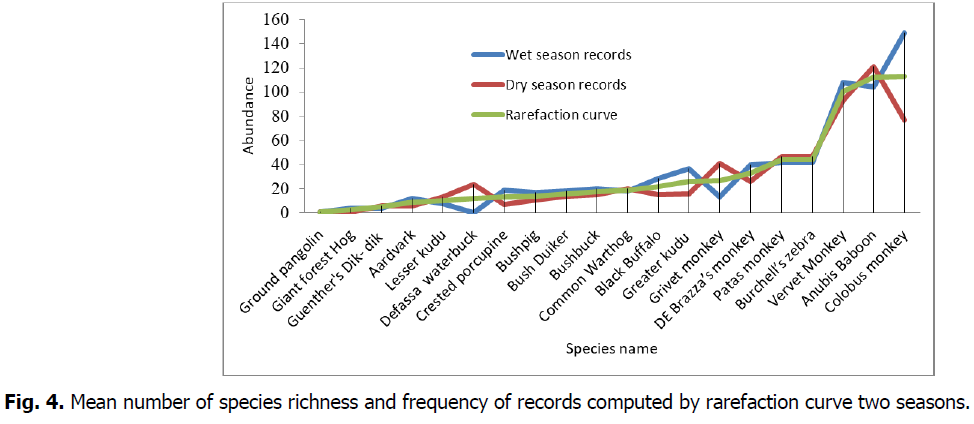
Fig 4: Mean number of species richness and frequency of records computed by rarefaction curve two seasons.
| Species | Forestland | Wooded grassland | Total | |||
|---|---|---|---|---|---|---|
| Wet | dry | wet | dry | Wet | Dry | |
| Vervet Monkey (Cercopithecus pygerythrus) | 99 | 82 | 9 | 11 | 108 | 93 |
| Grivet monkey (Cercopithecus aethiops) | - | 8 | 13 | 33 | 13 | 41 |
| Anubis Baboon (Papio anubis) | 65 | 68 | 39 | 53 | 104 | 121 |
| Patas monkey (Erytherocebus patas) | - | - | 42 | 47 | 42 | 47 |
| DE Brazza’s monkey (Cercopitheus neglectus) | 40 | 26 | - | - | 40 | 26 |
| Colobus monkey (Colobus guereza) | 131 | 63 | 18 | 14 | 149 | 77 |
| Burchell’s zebra (Equus quagga) | - | 6 | 42 | 39 | 42 | 47 |
| Greater kudu (Traglaphus strepsiceros) | - | 5 | 37 | 11 | 37 | 16 |
| Lesser kudu (Traglaphus imberbis) | - | - | 8 | 13 | 8 | 13 |
| Bushbuck (Traglaphus scriptus) | 16 | 13 | 4 | 2 | 20 | 15 |
| Guenther's Dik- dik (Medagua guentheri) | - | - | 4 | 6 | 4 | 6 |
| Bush Duiker (Sylvicapra grimma) | 14 | 9 | 4 | 5 | 18 | 14 |
| Defassa waterbuck (Kobus ellipsiprymnus defessa) | - | - | - | 24 | - | 24 |
| Black Buffalo (Syncerrus caffer) | 1 | 1 | 28 | 14 | 29 | 15 |
| Bushpig (Potamochoerus larvatus) | 8 | 7 | 9 | 4 | 17 | 11 |
| Common Warthog (Phacochoerus africanus) | - | 10 | 18 | 10 | 18 | 20 |
| Giant forest Hog (Hylochoerus meinertzhageni) | 4 | 1 | - | - | 4 | 1 |
| Crested porcupine (Hystrix cristata) | 3 | 2 | 16 | 5 | 19 | 7 |
| Aardvark (Orycteropus afer) | - | - | 12 | 6 | 12 | 6 |
| Ground pangolin (Phataginus temminckii smutus) | - | - | 1 | 1 | 1 | 1 |
| Total No. of individuals per habitat | 381 ± 7 | 302 ± 5 | 304 ± 3 | 298 ± 3 | 685 ± 7 | 600 ± 6 |
| Total No. of species per habitat | 10 | 14 | 17 | 18 | 19 | 20 |
Table 3. Seasonal species composition and abundance of mammals among different habitats in BCMF.
Relative abundance
A total of 20 mammalian species with 1,285 ± 20 individuals were recorded during the transect walk in both seasons. Of all mammals, 685 ± 7 (53.33%) individuals were recorded during the wet season and 600 ± 6 (46.69%) individuals were recorded in the dry season Thus, seasonal abundance was significant (χ2=5.614, df=1, p<0.05). A total of 558 km transect walk was made in 11 transects in BCMF. The encounter rate of species was also varied between seasons and habitat types. Colobus monkey (Colobus guereza) and Anubis Baboon (Papio anubis) were the most encountered species (0.40 sighting/km), followed by Vervet Monkey (Cercopithecus pygerythrus) (0.36 sighting/km) were high encounter rate category. Patas monkey (Erytherocebus patas) (0.16 sighting/km), Burchell’s zebra (Equus quagga) (0.15 sighting/km), DE Brazza’s monkey (Cercopitheus neglectus) (0.12 sighting/km), Grivet monkey (Cercopithecus aethiops) (0.10 sighting/km), were under least encounter rate category. Mammals with the encountered rate<0.1 were Grivet monkey (Cercopithecus aethiops) (0.09 sighting/km), Greater kudu (Traglaphus strepsiceros) (0.09 sighting/km), Black Buffalo (Syncerrus caffer) (0.08 sighting/km), Common Warthog (Phacochoerus africanus) (0.04 sighting/km), Aardvark (Orycteropus afer) (0.03 sighting/km), Ground pangolin (Phataginus temminckii smutus) (0.003 sighting/km), Crested porcupine (Hystrix Cristata) (0.05 sighting/km), Giant forest Hog (Hylochoerus meinertzhageni) (0.01 sighting/km), Bushpig (Potamochoerus larvatus) (0.05 sighting/km), Defassa waterbuck (Kobus ellipsiprymnus defessa) (0.04 sighting/km), Bush Duiker (Sylvicapra grimma) (0.05 sighting/km), Guenther's Dik-dik (Medagua guentheri) (0.02 sighting/km), Bushbuck (Traglaphus Scriptus) (0.06 sighting/km), Lesser kudu (Traglaphus imberbis) (0.04 sighting/km). The highest encountered rate of diurnal mammals was recorded in forestland (0.23 sighting/km) whereas the lowest was in wooded grassland (0.0018 sighting/km) (Table 4 and Fig. 5, 6).
| Species | Forestland | Wooded grassland | Er in both season | Total | Er | |||||||||
|---|---|---|---|---|---|---|---|---|---|---|---|---|---|---|
| Wet | Er | Dry | Er | Wet | Er | Dry | Er | Wet | Er | Dry | Er | |||
| Vervet Monkey (Cercopithecus pygerythrus) | 99 | 0.18 | 82 | 0.15 | 9 | 0.016 | 11 | 0.019 | 108 | 0.19 | 93 | 0.167 | 201 | 0.36 |
| Grivet monkey (Cercopithecus aethiops) | - | 8 | 0.014 | 13 | 0.023 | 33 | 0.023 | 13 | 0.023 | 41 | 0.073 | 54 | 0.10 | |
| Anubis Baboon (Papio anubis) | 65 | 0.12 | 68 | 0.12 | 39 | 0.069 | 53 | 0.095 | 104 | 0.18 | 121 | 0.21 | 225 | 0.40 |
| Patas monkey (Erytherocebus patas) | - | - | - | 42 | 0.07 | 47 | 0.084 | 42 | 0.075 | 47 | 0.084 | 89 | 0.16 | |
| DE Brazza’s monkey (Cercopitheus neglectus) | 40 | 0.07 | 26 | 0.04 | - | - | - | - | 40 | 0.070 | 26 | 0.046 | 66 | 0.12 |
| Colobus monkey (Colobus guereza) | 131 | 0.23 | 63 | 0.11 | 18 | 0.032 | 14 | 0.025 | 149 | 0.26 | 77 | 0.13 | 226 | 0.40 |
| Burchell’s zebra (Equus quagga) | - | - | 6 | 0.01 | 42 | 0.075 | 39 | 0.069 | 42 | 0.071 | 47 | 0.084 | 87 | 0.15 |
| Greater kudu (Traglaphus strepsiceros) | - | - | 5 | 0.008 | 37 | 0.066 | 11 | 0.019 | 37 | 0.066 | 16 | 0.028 | 53 | 0.09 |
| Lesser kudu (Traglaphus imberbis) | - | - | - | - | 8 | 0.014 | 13 | 0.023 | 8 | 0.014 | 13 | 0.023 | 21 | 0.04 |
| Bushbuck (Traglaphus scriptus) | 16 | 0.02 | 13 | 0.023 | 4 | 0.007 | 2 | 0.003 | 20 | 0.035 | 15 | 0.026 | 35 | 0.06 |
| Guenther's Dik-dik (Medagua guentheri) | - | - | - | - | 4 | 0.007 | 6 | 0.001 | 4 | 0.007 | 6 | 0.01 | 10 | 0.02 |
| Bush Duiker (Sylvicapra grimma) | 14 | 0.03 | 9 | 0.016 | 4 | 0.007 | 5 | 0.089 | 18 | 0.032 | 14 | 0.032 | 32 | 0.05 |
| Defassa Waterbuck (Kobus ellipsiprymnus defessa) | - | - | - | - | - | - | 24 | 0.043 | - | - | 24 | 0.043 | 24 | 0.04 |
| Black Buffalo (Syncerrus caffer) | 1 | 0.0018 | 1 | 0.0018 | 28 | 0.050 | 14 | 0.032 | 29 | 0.051 | 15 | 0.026 | 44 | 0.07 |
| Bushpig (Potamochoerus larvatus) | 8 | 0.014 | 7 | 0.011 | 9 | 0.016 | 4 | 0.007 | 17 | 0.003 | 11 | 0.019 | 28 | 0.05 |
| Common Warthog (Phacochoerus africanus) | - | - | 10 | 0.05 | 18 | 0.032 | 10 | 0.017 | 18 | 0.032 | 20 | 0.035 | 38 | 0.07 |
| Giant forest Hog (Hylochoerus meinertzhageni | 4 | 0.007 | 1 | 0.0018 | - | - | - | - | 4 | 0.007 | 1 | 0.0018 | 6 | 0.01 |
| Crested porcupine (Hystrix cristata) | 3 | 0.005 | 2 | 0.003 | 16 | 0.028 | 5 | 0.089 | 19 | 0.034 | 7 | 0.012 | 26 | 0.05 |
| Aardvark (Orycteropus afer) | - | - | - | - | 12 | 0.021 | 6 | 0.001 | 12 | 0.021 | 6 | 0.001 | 18 | 0.03 |
| Ground pangolin (Phataginus temminckii smutus) | - | - | - | - | 1 | 0.0018 | 1 | 0.0018 | 1 | 0.0018 | 1 | 0.0018 | 2 | 0.003 |
Table 4. Mammals recorded and their encounter rate in BCMF during wet and dry seasons.
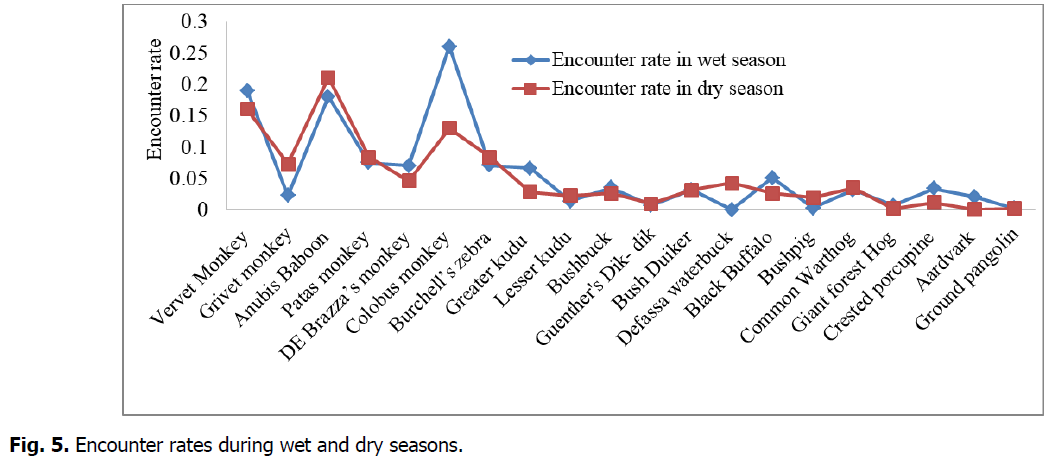
Fig 5: Encounter rates during wet and dry seasons.
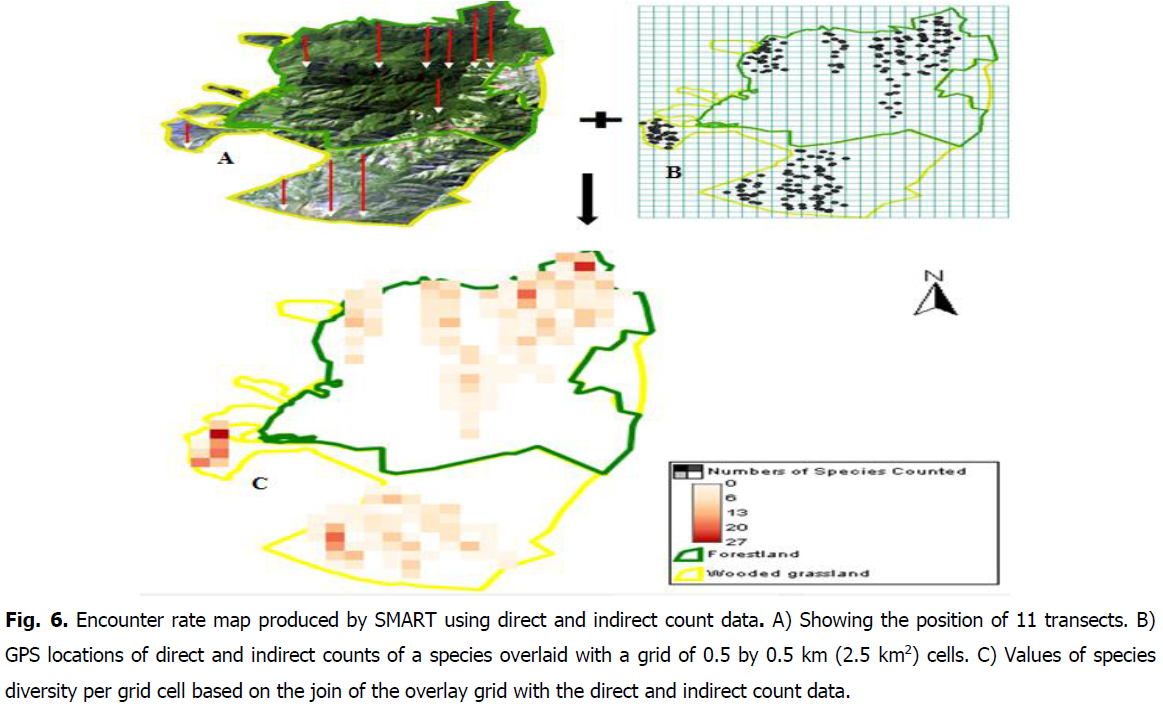
Fig 6: Encounter rate map produced by SMART using direct and indirect count data. A) Showing the position of 11 transects. B) GPS locations of direct and indirect counts of a species overlaid with a grid of 0.5 by 0.5 km (2.5 km2) cells. C) Values of species diversity per grid cell based on the join of the overlay grid with the direct and indirect count data.
Species diversity
The highest diversity was observed in wooded grassland during both wet and dry seasons (H’=2.53 and H’=2.50, respectively). Species diversity in forestland was H=1.69 and H=1.99, for wet and dry seasons, respectively. In general, high species diversity was recorded during the dry season in forestland habitats whereas during the wet season in wooded grassland habitats (Table 5).
| Habitat | Season | Minimum number of species encountered | Nos. of individual | H | Hmax | (J) Evenness |
|---|---|---|---|---|---|---|
| Forestland | Wet | 10 | 381 ± 7 | 1.69 | 2.30 | 0.73 |
| Dry | 14 | 302 ± 7 | 1.99 | 2.64 | 0.75 | |
| WoodedgrassL | Wet | 17 | 304 ± 3 | 2.53 | 2.83 | 0.89 |
| Dry | 18 | 298 ± 3 | 2.50 | 2.94 | 0.85 |
Table 5. Species diversity based on habitat and season.
Sex ratio
The sex ratios of mammals from two different seasons given in Fig. 7. Overall, female and male individuals (excluding young individuals whose sex could not be identified) comprised 508 (39.53%) and male 497 (38.68%), respectively. Thus, the sex ratio of males to females was 0.98:1.00 which was female-biased. However, in some species such as Guenther’s Dik-dik (Medagua guentheri) sex ratio was 1:00:1:00; whereas in Patas monkey (Erytherocebus patas), Colobus monkey (Colobus guereza), Burchell’s zebra (Equus quagga), Lesser kudu (Traglaphus imberbis), Bush Duiker (Sylvicapra grimma), Defassa waterbuck (Kobus ellipsiprymnus defessa), Common Warthog (Phacochoerus africanus), it was male-biased.
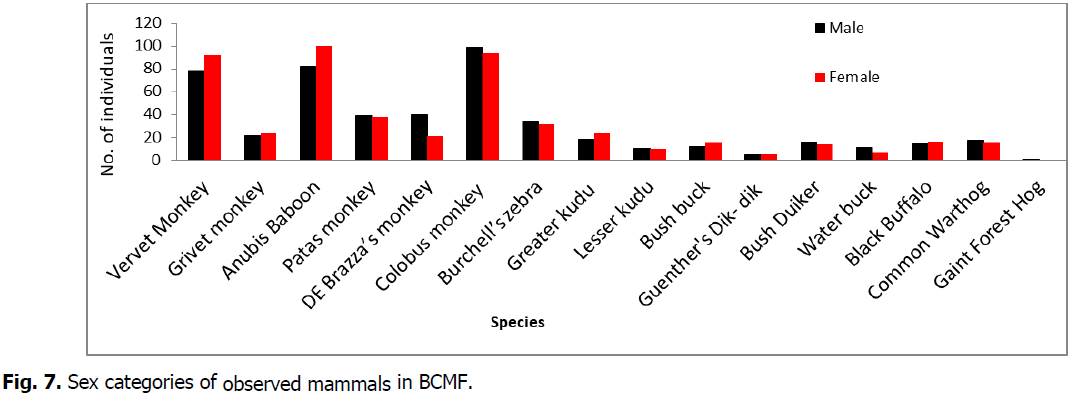
Fig 7: Sex categories of observed mammals in BCMF.
Age structure
The age structure of mammals in the present study was presented in (Fig. 8). Thus, overall, the age structure was comprised of a predominantly adult population. During the wet season, 174 (24.40%) adult-male, 194 (28.32%) adult-female, 95 (13.87%) sub-adult male, 84 (12.26%) sub-adult female, 94 (13.75%) young, and 44 (6.42%) unknown age were identified. On the other hand, during the dry season, 172 (28.67%) adult-male, 189 (31.50%) adult-female, 85 (14.17%) sub-adult-male, 61 (10.17%) sub-adult female, 58 (9.67%) young, and 35 (5.83%) unknown Age structure were identified. The Age structure of adult to young was varying from species to species. However, in some species such as Grivet monkey age ratio was 1:00:1:00; whereas in Patas monkey (Erytherocebus patas), Defassa waterbuck (Kobus ellipsiprymnus defessa), and Black Buffalo (Syncerrus caffer) it was young dominated. The overall, age ratio of adult to young was 1:0.74 and 1:0.57 during the wet and dry seasons, respectively.
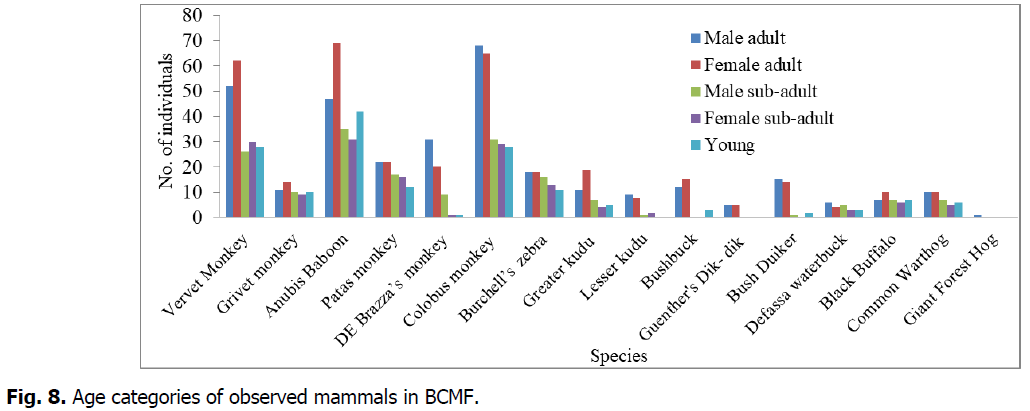
Fig 8: Age categories of observed mammals in BCMF.
Discussion
Species composition is one of the ecological parameters that depicts the suitability of a certain habitat in hosting a variety of species. In the present study, 20 mammalian species that belong to six orders and eight families were identified. The orders of mammalian species recorded in BCMF were lower and higher than in the study conducted on mammals at different localities in the country. For instance, lower records include five orders and seven families in Geremba Mountain Fragments community-managed area, Southern Ethiopia; four orders and five families in the Humbo Community-Based Forest Area, Southern Ethiopia; five orders and eleven families in Michole Community Protected Forest, Southern Ethiopia, and four orders and twelve families in and around Wondo Genet Forest Patches. On the other hand, higher records include, seven orders and fourteen families in Adaba Community Forest, West Arsi Zone, Southeast Ethiopia; eight orders and eleven families in Mengaza communal forest, East Gojjam, Ethiopia, and five orders and fourteen families in Fragmented Remnant Forests around Asella Town, Ethiopia. Therefore, the presence of relatively high numbers of orders and families in the study area indicates the great potential of the area harboring different species.
Among the six orders, Artiodactyla had the highest species richness (n=10) as compared to other orders recorded in the study area. This is in agreement with the study in Adaba Community Forest, West Arsi Zone, Southeast Ethiopia where Artiodactyla was the most abundant order containing more species. Primate had the second-highest species richness in the study area. A study carried out at Adaba Community Forest, West Arsi Zone, Southeast Ethiopia has also reported the high number of species under order primate.
In terms of number of mammalian species identified, the study area comprises relatively lower and higher number of species as compared to other similar studies in the country. For instance, lower records include 10 species in Geremba Mountain Fragments community-managed area, Southern Ethiopia; 8 species in Humbo Community Forest Area, Southern Ethiopia; 12 species in Mengaza communal forest, East Gojjam (Atnafu and Yihune, 2017); 19 species in Michole Community Protected Forest, Southern Ethiopia, and 19 species in Wondo Genet Forest Patches. On the other hand, higher record include 27 species in Adaba Community Forest, West Arsi Zone, Southeast Ethiopia, and 22 species in Fragmented Remnant Forests around Asella Town, Ethiopia. In general, high reproductive success, adaptability to different habitats, diversified foraging behaviour, food source availability and high tolerance level to anthropogenic disturbances might attribute to high species richness in the study area.
In the study area, a total of 1,285 ± 20 individual mammals were recorded during the study period. Earlier studies at different parts of the country reported both lower and higher numbers of individual mammals compared to the present finding. For instance, lower records include 227 individuals in Geremba Mountain Fragments, Southern Ethiopia; 647 individuals in Michole Community Protected Forest, Southern Ethiopia; 202 individuals in Fragmented Remnant Forests around Asella Town, Ethiopia, and 315 individual in Mengaza communal forest, East Gojjam. On the other hand higher records include, 3648 individuals in Humbo Community-Managed Forest, Southern Ethiopia; 2005 individuals in Adaba Community Forest, West Arsi Zone, Southeast Ethiopia, and 7168 individuals in and around Wondo Genet Forest Patches. The size of the study area, nature of the habitat, methodology, study duration, and climatic factors might contribute to such variation of reported results.
Based on season and habitat types, in the former case, more individuals were recorded during the wet season (n=685). This might be due to good food availability and enivromental factors that matches with the reproductive season of most mammalian species. A similar study reported more individuals during the wet season than the dry season. Furthermore, during wet season more number of individuals were reported as compared to the dry season With regard to habitat types, high species diversity was recorded in wooded grassland during both wet and dry seasons (H’=2.53 and H’=2.50, respectively). High species diversity in the wooded grassland might be due to relatively better vegetation diversity in the study area. suggest that high diversity in vegetation supports a high diversity of mammals species.
Primates such as Colobus monkey (Colobus guereza) and Anubis Babbon (Papio Anubis) (0.40 sighting/km), and Vervet monkey (Cercopithecus pygerythrus) (0.36 sighting/km) were the most encountered species during the study. Consequently, the relative abundance of these species was higher as compared to others. Analogously, several studies have also reported a higher relative abundance of primates than other orders from different parts of Ethiopia.
The sex ratios and age distribution among the mammalian populations is vital for evaluating the viability of the species as these variables reflect the structure and the dynamics of the population. The overall sex ratio irrespective of species in the present study was female-biased. Thus, it indicates that more females are found in the population. One probable reason might be poaching (whenever there is) favoured females as in most species males are larger than females. The adult males are mostly selected for skin and horns for cultural decoration. The revealed sex-specific factors such as breeding and maternal behaviours, affecting movement and home range size and ultimately influence the encounter rate of males and females. More mentioned that more solitary habits, proneness to injuries from intra-specific aggression, lack of alertness during the rut, and dispersal behaviour may render male individuals to be more vulnerable to predation by large carnivores that ultimately reduce male individuals in a population. On the other hand, the overall age ratio of adult to young was 1:0.74 and 1:0.57 during wet and dry seasons in the study area. However specific to species, young dominated as well as 1:1 ratio of adult to young were also recorded. Adult dominated and young dominated age structures indicate a stable and an increasing population, respectively.
Conclusion
The occurrence of 20 mammalian species that belong to six orders and eight families indicates that BCMF is an important area that harbours diverse mammalian species. Thus, it is very important to sustain the existence of these species by strengthening the conservation approach practised in the area. Despite different encounter rates of species, the overall relative abundance of 1285 individuals in the study area show the good carrying capacity of the forest even in the presence of some threats. Significant difference in species composition was observed between habitat types. Hence, the highest species richness was recorded in the wooded grassland whereas the lowest was in forestland. Therefore, this indicates habitat type determined the distribution of some species. On the other hand, seasonal variation in the number of mammals was not statistically significant. Thus, the season was not a factor to determine species richness in the study area.
The presence of female-biased, male-biased and 1:1 male to female ratios among identified mammalian species indicates the difference in sex structure of the species that ultimately determine the population structure of each species. Furthermore, the occurrence of high young to adult and adult (particularly females) to young ratios portrays a growing population and stable population, respectively.
Recommendations
Based on the findings of the present study, the following recommendations are forwarded:
• Illegal activities such as poaching, fuel wood collection and grass cutting in the Bayo community managed forest should be controlled, developing awareness of the community and respective role of them and other stakeholders.
• Other ecological aspects such as feeding ecology, diurnal activity pattern and behavioral ecology should be studied in order to obtain better understanding about mammals in the study area.
• As BCMF is endowed with high biodiversity, survey on small mammals, avians, and carnivores species should also be encouraged.
• The local government should promote the study area and provide appropriate support towards it conservation.
Acknowledgment
The authors would like to acknowledge the Ethiopian Wildlife Conservation Authority and Nech Sar National Park for financing this research, thank the Department of Biology, College of Natural and Computational Sciences, Arba Minch University, for their valuable support in different ways. profound pleasure to acknowledge South Omo Zone and Salamago Woreda Environment, Forest and Biodiversity department, for their support during the study. would like to thank all the community members of the Bayo community-managed forest for their full-hearted cooperation Special thanks to Bayo community Rangers Mr Ermiju Niguse, Kalado Bodi, Lechune Nebegase, Demeke Tadese, Tsega Mamo, Melkamu Toyeka, Niguse Getahune, Amaro Derase, Alemu Erimas for their special hospitality and tireless service of Ranging and experience sharing during data collection inside and surrounding the forest.
Conflict of Interest
The authors declare no conflict of interest.
References
Ghose, K.C., Manna, B. (2003). Fundamental of Zoology. New Central. Book Agency Ltd, New Delhi.
Wilson, D.E., Reeder, D.M. (2005). Mammal species of the world: a taxonomic and geographic reference. JHU Press.
Kingdon, J., Largen, M.J. (1997). The kingdom field guide to African mammals. Zoological Journal of the Linnean Society, 120:479.
Gebo, B., Takele, S., Shibru, S. (2021). Impacts of habitats and seasons on mammalian diversity and distribution in the Faragosa-Fura landscape, Gamo Zone, Southern Ethiopia. Geology, Ecology, and Landscapes, pp:1-12.
Bussmann, R.W. (2006). Vegetation zonation and nomenclature of African Mountains-an overview. Lyonia, 11:41-66.
Akinsorotan, O.A. (2017). Status and determinants of large mammal occupancy in a Nigerian protected area. Nottingham Trent University (United Kingdom).
Agebo, A., Tekalign, W. (2022). Terrestrial medium and large-sized mammalian species diversity in Michole Community Protected Forest, southern Ethiopia. BMC Zoology, 7:20.
E Wildlife Natural History Society. (1996). Important bird areas of Ethiopia: A first inventory. Ethiopian Wildlife and Natural History Society, Addis Ababa, pp:55-60.
Asefa, M., Cao, M., He, Y., Mekonnen, E., Song, X., Yang, J. (2020). Ethiopian vegetation types, climate and topography. Plant Diversity, 42:302-311.
Google Scholar, Crossref, Indexed at
Ib, F., Sebsebe, D., Breugel, P.V. (2010). Atlas of the potential vegetation of Ethiopia. Atlas of the Potential Vegetation of Ethiopia.
Getahun, A.A. (2018). The status of ecosystem resources in Ethiopia: Potentials, challenges and threats: Review paper. Journal of Biodiversity and Endangered Species, 6:1-4.
Ethiopia Biodiversity Institute (EBI). (2014). Ethiopia’s fifth national report to the convention on biological diversity. Ethiopian Biodiversity Institute, Addis Ababa.
Ethiopian Wildlife Conservation Authority (EWCA). (2020). Review of the Leopard (Pantherapardus) quota of Ethiopia, established per Resolution Conf. (Rev. CoP16) and non-detriment determinations, in accordance with CITES Decision.
Lavrenchenko, L.A., Bekele, A. (2017). Diversity and conservation of Ethiopian mammals: what have we learned in 30 years?. Ethiopian Journal of Biological Sciences, 16:1-20.
Craig, E.W., Stanley, W.T., Kerbis Peterhans, J.C., Bryja, J., Meheretu, Y. (2020). Small terrestrial mammal distributions in Simien Mountains National Park, Ethiopia: a reassessment after 88 years. Journal of Mammalogy, 101:634-647.
Author Info
T.H. Chankallo1* and S.T. Kabtehyimer22Department of Biology, College of Natural and Computational Sciences, Arba Minch University, Ethiopia
Citation: Chankallo, T.H., Kabtehyimer, S.T. (2023). Diversity of diurnal large mammals in bayo community managed forest, salamago woreda, south omo zone, Southern Ethiopia. Ukrainian Journal of Ecology. 13:1-14.
Received: 11-Mar-2023, Manuscript No. UJE-23-92517; , Pre QC No. P-92517; Editor assigned: 13-Mar-2023, Pre QC No. P-92517; Reviewed: 25-Mar-2023, QC No. Q-92517; Revised: 01-Apr-2023, Manuscript No. R-92517; Published: 08-Apr-2023, DOI: 10.15421/2023_433
Copyright: This is an open access article distributed under the terms of the Creative Commons Attribution License, which permits unrestricted use, distribution, and reproduction in any medium, provided the original work is properly cited.

